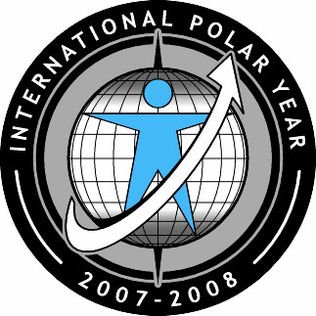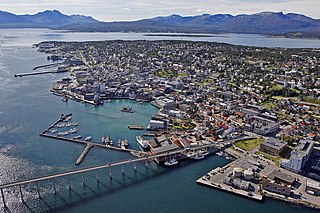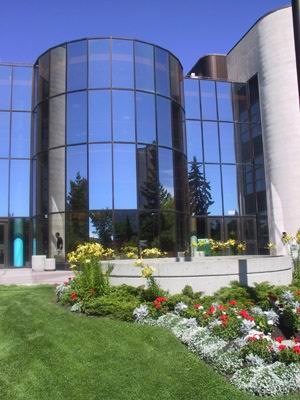Related Research Articles

The International Polar Years (IPY) are collaborative, international efforts with intensive research focus on the polar regions. Karl Weyprecht, an Austro-Hungarian naval officer, motivated the endeavor in 1875, but died before it first occurred in 1882–1883. Fifty years later (1932–1933) a second IPY took place. The International Geophysical Year was inspired by the IPY and was organized 75 years after the first IPY (1957–58). The fourth, and most recent, IPY covered two full annual cycles from March 2007 to March 2009.

The University of Tromsø – The Arctic University of Norway is a state university in Norway and the world's northernmost university. Located in the city of Tromsø, Norway, it was established by an act of parliament in 1968, and opened in 1972. It is one of ten universities in Norway. The University of Tromsø is the largest research and educational institution in Northern Norway and the sixth-largest university in Norway. The university's location makes it a natural venue for the development of studies of the region's natural environment, culture, and society.

Rovaniemi is a city in Finland and the regional capital of Lapland. It is located near the Arctic Circle in the northern interior of the country. The population of Rovaniemi is approximately 65,000, while the sub-region has a population of approximately 69,000. It is the 17th most populous municipality in Finland, and the 12th most populous urban area in the country.

Tromsø is a municipality in Troms county, Norway. The administrative centre of the municipality is the city of Tromsø.

Midnightsun, also known as polar day, is a natural phenomenon that occurs in the summer months in places north of the Arctic Circle or south of the Antarctic Circle, when the Sun remains visible at the local midnight. When midnight sun is seen in the Arctic, the Sun appears to move from left to right. In Antarctica, the equivalent apparent motion is from right to left. This occurs at latitudes ranging from approximately 65°44' to exactly 90° north or south, and does not stop exactly at the Arctic Circle or the Antarctic Circle, due to refraction.

The Scott Polar Research Institute (SPRI) is a centre for research into the polar regions and glaciology worldwide. It is a sub-department of the Department of Geography in the University of Cambridge, located on Lensfield Road in the south of Cambridge.
Native American studies is an interdisciplinary academic field that examines the history, culture, politics, issues, spirituality, sociology and contemporary experience of Native peoples in North America, or, taking a hemispheric approach, the Americas. Increasingly, debate has focused on the differences rather than the similarities between other Ethnic studies disciplines such as African American studies, Asian American Studies, and Latino/a Studies.

Rovaniemi Airport is the second busiest Airport in Finland after Helsinki-Vantaa, as measured by the number of passengers and landings. It's located in Rovaniemi, Finland, about 10 kilometres (6 mi) north of Rovaniemi city centre. The Arctic Circle crosses the runway closer to its northern end.

The history of the Northwest Territories covers the period from thousands of years ago to the present day. Prior to European colonization, the lands that encompass present-day Northwest Territories were inhabited for millennia by several First Nations. European explorers and fur traders began to explore the region since the late-16th century. By the 17th century, the British laid claim to both the North-Western Territory and Rupert's Land; and granted the Hudson's Bay Company a commercial fur trade monopoly over the latter region.

The Arctic Environmental Protection Strategy (AEPS) is a multilateral, non-binding agreement among Arctic states on environmental protection in the Arctic. Discussions began in 1989, with the AEPS adopted in June 1991 by Canada, Denmark, Finland, Iceland, Norway, Sweden, the Soviet Union, and the United States. The AEPS deals with monitoring, assessment, protection, emergency preparedness/response, and conservation of the Arctic zone. It has been called a major political accomplishment of the post–Cold War era.

The Circumpolar Health Bibliographic Database (CHBD) is a free electronic database of abstracts, citations, geographic and subject indexing, library codes and their links to full text publications, both peer-reviewed and gray literature. Established in 2007, it contains more than sixty five hundred records that describe human health in the circumpolar region. The CHBD is a circumpolar chronic disease prevention project of the Canadian Institutes of Health Research. It is maintained by the University of Calgary in Calgary, Alberta, Canada.

Arctic cooperation and politics are partially coordinated via the Arctic Council, composed of the eight Arctic nations: the United States, Canada, Iceland, Norway, Sweden, Finland, Russia, and Denmark with Greenland and the Faroe Islands. The dominant governmental power in Arctic policy resides within the executive offices, legislative bodies, and implementing agencies of the eight Arctic nations, and to a lesser extent other nations, such as United Kingdom, Germany, European Union and China. NGOs and academia play a large part in Arctic policy. Also important are intergovernmental bodies such as the United Nations and NATO.

The Arctic Circle is one of the two polar circles, and the most northerly of the five major circles of latitude as shown on maps of Earth at about 66° 34' N. Its southern equivalent is the Antarctic Circle.

Polar Research and Policy Initiative, commonly known as PRPI or The Polar Connection, is an independent, international foreign policy think tank dedicated primarily to the Arctic, Nordic, Baltic and Antarctic regions, as well as energy and environment issues. PRPI is headquartered in London, United Kingdom and has an international presence across North America, Europe and the Asia-Pacific through the geographic distribution of its fellows, advisors, and affiliates. PRPI aims to promote sustainable regional development through multi-stakeholder, multi-sectoral and multi-national dialogue and cooperation.
Circumpolar studies is an interdisciplinary field of study combining social science and geoscience and involving topics like land, environment, peoples, cultures, and politics in Arctic and Subarctic states, that is, the United States (Alaska), Canada, Denmark (Greenland), Iceland, Norway, Sweden, Finland, and Russia. Because of circumpolar regions' past as colonised territories inhabited by nomads, circumpolar studies focusses on indigenous peoples as well as early agricultural settlers.

Tromsø is a city in Tromsø Municipality in Troms county, Norway. The city is the administrative centre of the municipality as well as the administrative centre of Troms county. The Diocese of Nord-Hålogaland and its Bishop are based at the Tromsø Cathedral in the city. The city is located on the island of Tromsøya which sits in the Tromsøysundet strait, just off the mainland of Northern Norway. The mainland suburb of Tromsdalen is connected to the city centre on Tromsøya by the Tromsø Bridge and the Tromsøysund Tunnel. The suburb of Kvaløysletta on the island of Kvaløya is connected to the city centre by the Sandnessund Bridge.

The Arctic Railway is a planned railway line linking the Norwegian Arctic port of Kirkenes with the Finnish railway network.

The history of Islam in the Arctic starts relatively late in the chronology of Islamic history, the Arctic Circle being at a great distance from traditional Muslim bastions of power and settlement. The "climatic conditions, remoteness and heavy industrial character" of northern cities have resulted in a unique cultural shift for Muslims living in the region, including a tendency towards pluralism wherein sects like Sunni and Shia Muslims do not segregate themselves. In areas where the midnight sun or polar night renders the five daily prayers impossible to tie to dusk and dawn, congregants typically either use the same timing as a more southern region, the holy city of Mecca or their homelands.

The Arctic Economic Council (AEC) is an independent international business membership organisation representing companies that work with and within the Arctic. The AEC advocates sustainable economic development in the region and represents a business perspective on sustainability. The AEC is the only regional business organisation in the Arctic and has members from all eight Arctic states.
References
- 1 2 Corley-Murchison, Nora T. (2001). "Northern/Polar Library Colloquy: a brief history" (PDF). Polar Libraries Bulletin. 48–49: 7.
- ↑ Campbell, Sandy (Summer 2005). "Polar Libraries Colloquy Joins University of the Arctic: Report from the 8th University of the Arctic Council Meeting" (PDF). Polar Libraries Bulletin. 57: 1, 4.
- ↑ Sarti, Silvia (Spring 2007). "Report of the 21st Polar Libraries Colloquy" (PDF). Polar Libraries Bulletin. 58: 1.
- ↑ Finn, Julia (2002). "The Hubert Wenger Award: Helping Participants Attend the Polar Libraries Colloquy" (PDF). Polar Libraries Bulletin. 48–49: 9.
- 1 2 Cooke, Geraldine A. (Nita). “The Northern Libraries Colloquy: a brief history”, Library Association of Alberta, vol. no. 3-4, October 1974, p. 101 – 103 (Boreal Institute for Northern Studies. Contribution no. 28.)https://era.library.ualberta.ca/items/181e5f6b-1bc4-42db-b88a-d7e9817d43a8
- 1 2 Andrews, Martha. "A Brief History of the Polar Libraries Colloquy/Northern Libraries Colloquy" Polar Libraries Colloquy, http://arcticcentre.ulapland.fi/polarweb/plc/hsty.asp